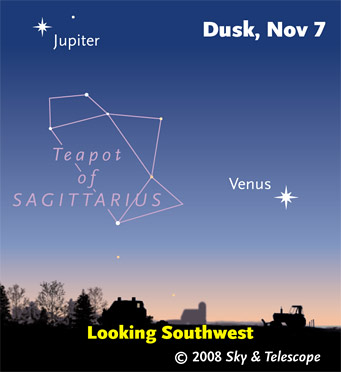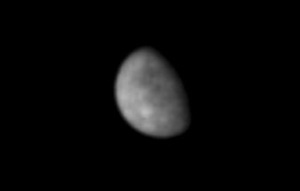Some daily events in the changing sky for October 31 – November 8.

Jupiter is moving in on Venus.... Keep watch all month.
Sky & Telescope diagram
Friday, October 31
Saturday, November 1
Sunday, November 2
Monday, November 3
Tuesday, November 4
Wednesday, November 5
Thursday, November 6
Friday, November 7
Saturday, November 8
Want to become a better amateur astronomer? Learn your way around the constellations. They're the key to locating everything fainter and deeper to hunt with binoculars or a telescope. For an easy-to-use constellation guide covering the whole evening sky, use the big monthly foldout map in each issue of Sky & Telescope, the essential magazine of astronomy. Or download our free Getting Started in Astronomy booklet (which only has bimonthly maps).

The Pocket Sky Atlas plots 30,796 stars to magnitude 7.6 — which may sound like a lot, but it's still less than one per square degree on the sky. Also plotted are many hundreds of good telescopic galaxies, star clusters, and nebulae.
Sky & Telescope
Once you get a telescope, to put it to good use you'll need a detailed, large-scale sky atlas (set of maps; the standards are Sky Atlas 2000.0 or the smaller Pocket Sky Atlas) and good deep-sky guidebooks (such as Sky Atlas 2000.0 Companion by Strong and Sinnott, the even more detailed Night Sky Observer's Guide by Kepple and Sanner, or the classic Burnham's Celestial Handbook). Read how to use them effectively.
Can a computerized telescope take their place? As Terence Dickinson and Alan Dyer say in their Backyard Astronomer's Guide, "A full appreciation of the universe cannot come without developing the skills to find things in the sky and understanding how the sky works. This knowledge comes only by spending time under the stars with star maps in hand and a curious mind." Without these, they wisely say, "the sky never becomes a friendly place."
More beginners' tips: "How to Start Right in Astronomy".
This Week's Planet Roundup

Planetary imager John Boudreau of Saugus, Mass., took advantage of Mercury's excellent elongation from the Sun last week. He got this remarkably detailed image of its Moon-like surface, with numerous features seen on Messenger spacecraft images, using an 11-inch Schmidt-Cassegrain telescope, a near-infrared filter (Astronomik 742 nanometers), and the stacked-video imaging method. He took this image at 14:10 UT October 27, 2008, with Mercury high in the sky in broad daylight.
Mercury has been having its best morning apparition of 2008. This week it remains bright (magnitude –0.8) but drops lower toward the dawn horizon. Look for it low in the east-southeast, very far below Saturn and a bit left, about 45 to 30 minutes before sunrise. Use binoculars to look for fainter Spica twinkling to Mercury's right early in the week, and upper right later in the week.
(You can always find your local sunrise time once you put your location into our online almanac. If you're off daylight saving time, make sure to uncheck the Daylight Saving Time box.)
Venus, very bright at magnitude –4.0, is getting higher in the southwest after sunset. In a telescope it's still small (14 arcseconds wide) and gibbous (78% illuminated).
Mars is lost in the sunset.
Vesta, the brightest asteroid, is at opposition, easily spottable with binoculars at magnitude 6.5 in the head of Cetus. It gets high late in the evening. Use the finder chart in the November Sky & Telescope, page 67.
Jupiter (bright at magnitude –2.1, in Sagittarius) shines in the south-southwest in twilight, and lower in the southwest later. For the next month watch Jupiter close in on Venus, which is currently far to its lower right, by 1° per day. They're 31° apart on October 31st and 24° apart on November 7th. These two brightest planets are heading toward a spectacular conjunction, 2° apart, on November 30th and December 1st.
Saturn (magnitude +1.1, in eastern Leo) rises around 2 a.m. standard time and shines well up in the east-southeast by early dawn. Don't confuse it with fainter Regulus about 18° (roughly two fist-widths at arm's length) to its upper right.
A telescope will show that Saturn's rings have turned nearly edge on; they're currently tilted 2° to our line of sight and closing. They'll reach a minimum of 0.8° at the end of the year, then start opening again.
Uranus and Neptune (magnitudes 5.8 and 7.9, respectively, in Aquarius and Capricornus) are in the south during early evening. Use our article and finder charts or the chart in the September Sky & Telescope, page 63.
Pluto is disappearing low in the southwest after dusk.
All descriptions that relate to your horizon or zenith — including the words up, down, right, and left — are written for the world's mid-northern latitudes. Descriptions that also depend on longitude (mainly Moon positions) are for North America. Eastern Daylight Time (EDT) equals Universal Time (known as UT, UTC, or GMT) minus 4 hours.
To be sure to get the current Sky at a Glance, bookmark this URL:
http://SkyandTelescope.com/observing/ataglance?1=1
If pictures fail to load, refresh the page. If they still fail to load, change the 1 at the end of this URL to any other character and try again.
 0
0
Comments
You must be logged in to post a comment.